Quality Assurance, Clinical Trials, and Regulatory Affairs
VerifiedAdded on 2022/12/17
|9
|2002
|61
AI Summary
This document provides information on quality assurance, clinical trials, and regulatory affairs in the development of new drugs. It covers topics such as regulatory compliances, preclinical pharmacology, stability testing, and the process of filing a new drug application. The document also discusses the guidelines and legislations that need to be followed in conducting clinical trials and obtaining regulatory approval.
Contribute Materials
Your contribution can guide someone’s learning journey. Share your
documents today.
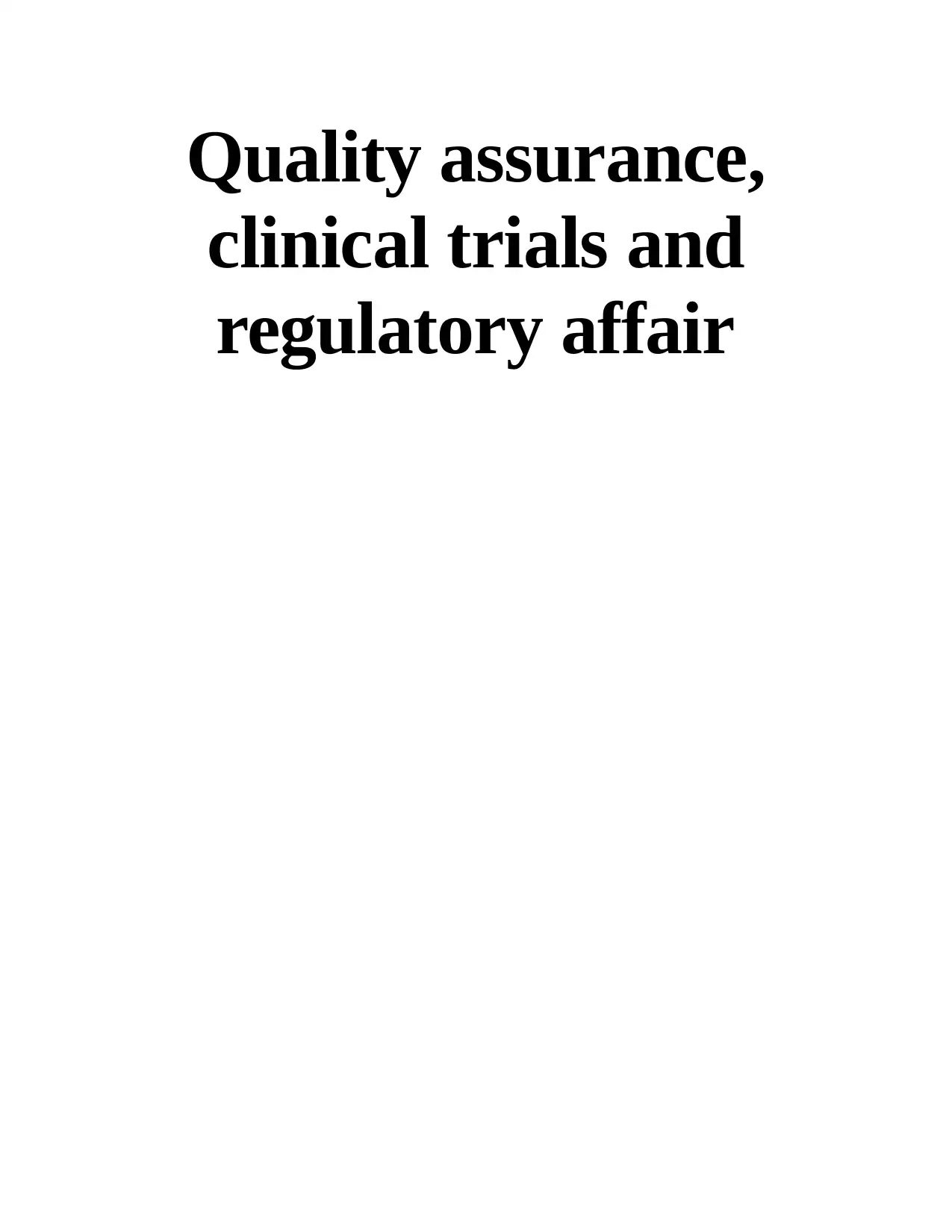
Quality assurance,
clinical trials and
regulatory affair
clinical trials and
regulatory affair
Secure Best Marks with AI Grader
Need help grading? Try our AI Grader for instant feedback on your assignments.


Contents
INTRODUCTION.....................................................................................................................................3
MAIN BODY.............................................................................................................................................3
CONCLUSION..........................................................................................................................................6
REFERNCES.............................................................................................................................................8
INTRODUCTION.....................................................................................................................................3
MAIN BODY.............................................................................................................................................3
CONCLUSION..........................................................................................................................................6
REFERNCES.............................................................................................................................................8
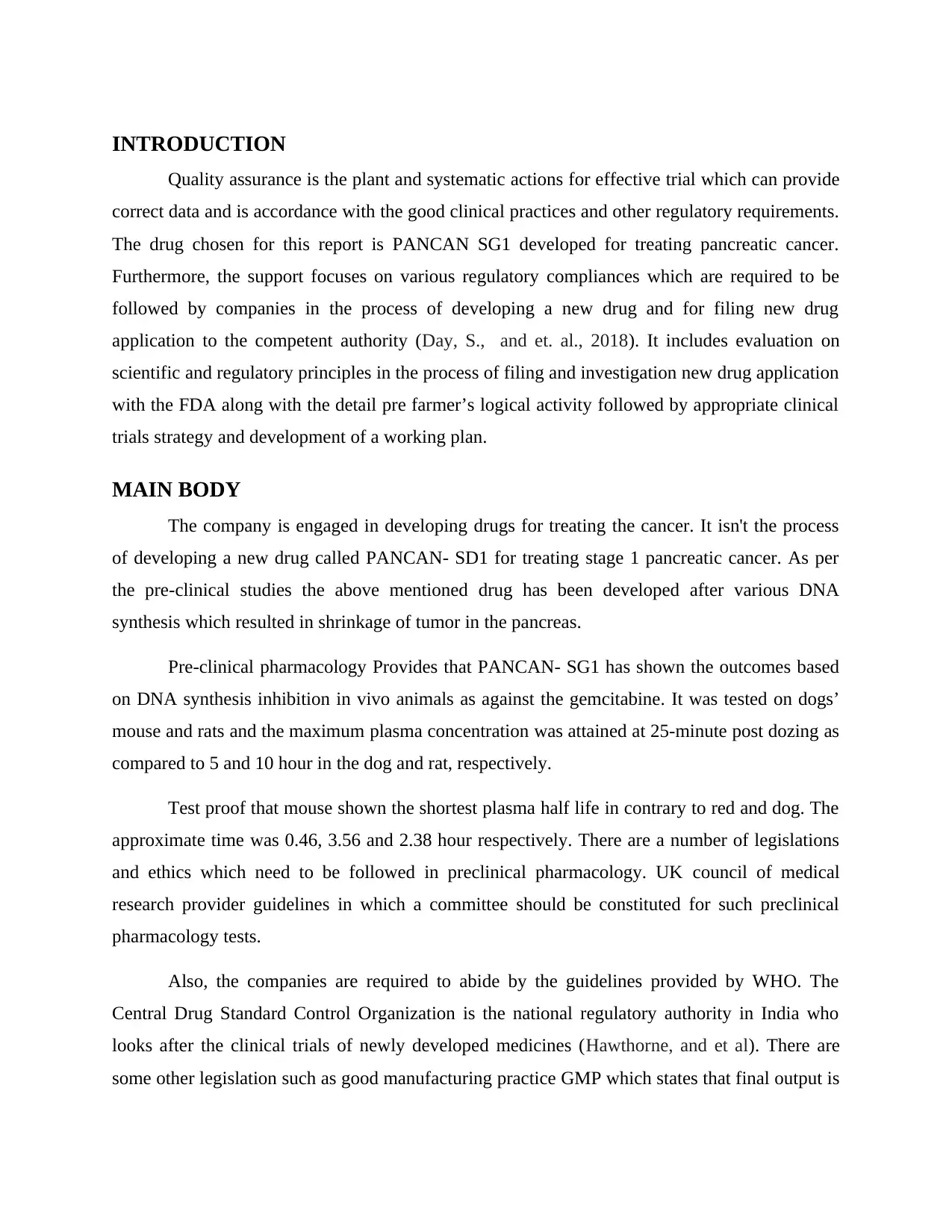
INTRODUCTION
Quality assurance is the plant and systematic actions for effective trial which can provide
correct data and is accordance with the good clinical practices and other regulatory requirements.
The drug chosen for this report is PANCAN SG1 developed for treating pancreatic cancer.
Furthermore, the support focuses on various regulatory compliances which are required to be
followed by companies in the process of developing a new drug and for filing new drug
application to the competent authority (Day, S., and et. al., 2018). It includes evaluation on
scientific and regulatory principles in the process of filing and investigation new drug application
with the FDA along with the detail pre farmer’s logical activity followed by appropriate clinical
trials strategy and development of a working plan.
MAIN BODY
The company is engaged in developing drugs for treating the cancer. It isn't the process
of developing a new drug called PANCAN- SD1 for treating stage 1 pancreatic cancer. As per
the pre-clinical studies the above mentioned drug has been developed after various DNA
synthesis which resulted in shrinkage of tumor in the pancreas.
Pre-clinical pharmacology Provides that PANCAN- SG1 has shown the outcomes based
on DNA synthesis inhibition in vivo animals as against the gemcitabine. It was tested on dogs’
mouse and rats and the maximum plasma concentration was attained at 25-minute post dozing as
compared to 5 and 10 hour in the dog and rat, respectively.
Test proof that mouse shown the shortest plasma half life in contrary to red and dog. The
approximate time was 0.46, 3.56 and 2.38 hour respectively. There are a number of legislations
and ethics which need to be followed in preclinical pharmacology. UK council of medical
research provider guidelines in which a committee should be constituted for such preclinical
pharmacology tests.
Also, the companies are required to abide by the guidelines provided by WHO. The
Central Drug Standard Control Organization is the national regulatory authority in India who
looks after the clinical trials of newly developed medicines (Hawthorne, and et al). There are
some other legislation such as good manufacturing practice GMP which states that final output is
Quality assurance is the plant and systematic actions for effective trial which can provide
correct data and is accordance with the good clinical practices and other regulatory requirements.
The drug chosen for this report is PANCAN SG1 developed for treating pancreatic cancer.
Furthermore, the support focuses on various regulatory compliances which are required to be
followed by companies in the process of developing a new drug and for filing new drug
application to the competent authority (Day, S., and et. al., 2018). It includes evaluation on
scientific and regulatory principles in the process of filing and investigation new drug application
with the FDA along with the detail pre farmer’s logical activity followed by appropriate clinical
trials strategy and development of a working plan.
MAIN BODY
The company is engaged in developing drugs for treating the cancer. It isn't the process
of developing a new drug called PANCAN- SD1 for treating stage 1 pancreatic cancer. As per
the pre-clinical studies the above mentioned drug has been developed after various DNA
synthesis which resulted in shrinkage of tumor in the pancreas.
Pre-clinical pharmacology Provides that PANCAN- SG1 has shown the outcomes based
on DNA synthesis inhibition in vivo animals as against the gemcitabine. It was tested on dogs’
mouse and rats and the maximum plasma concentration was attained at 25-minute post dozing as
compared to 5 and 10 hour in the dog and rat, respectively.
Test proof that mouse shown the shortest plasma half life in contrary to red and dog. The
approximate time was 0.46, 3.56 and 2.38 hour respectively. There are a number of legislations
and ethics which need to be followed in preclinical pharmacology. UK council of medical
research provider guidelines in which a committee should be constituted for such preclinical
pharmacology tests.
Also, the companies are required to abide by the guidelines provided by WHO. The
Central Drug Standard Control Organization is the national regulatory authority in India who
looks after the clinical trials of newly developed medicines (Hawthorne, and et al). There are
some other legislation such as good manufacturing practice GMP which states that final output is
Secure Best Marks with AI Grader
Need help grading? Try our AI Grader for instant feedback on your assignments.
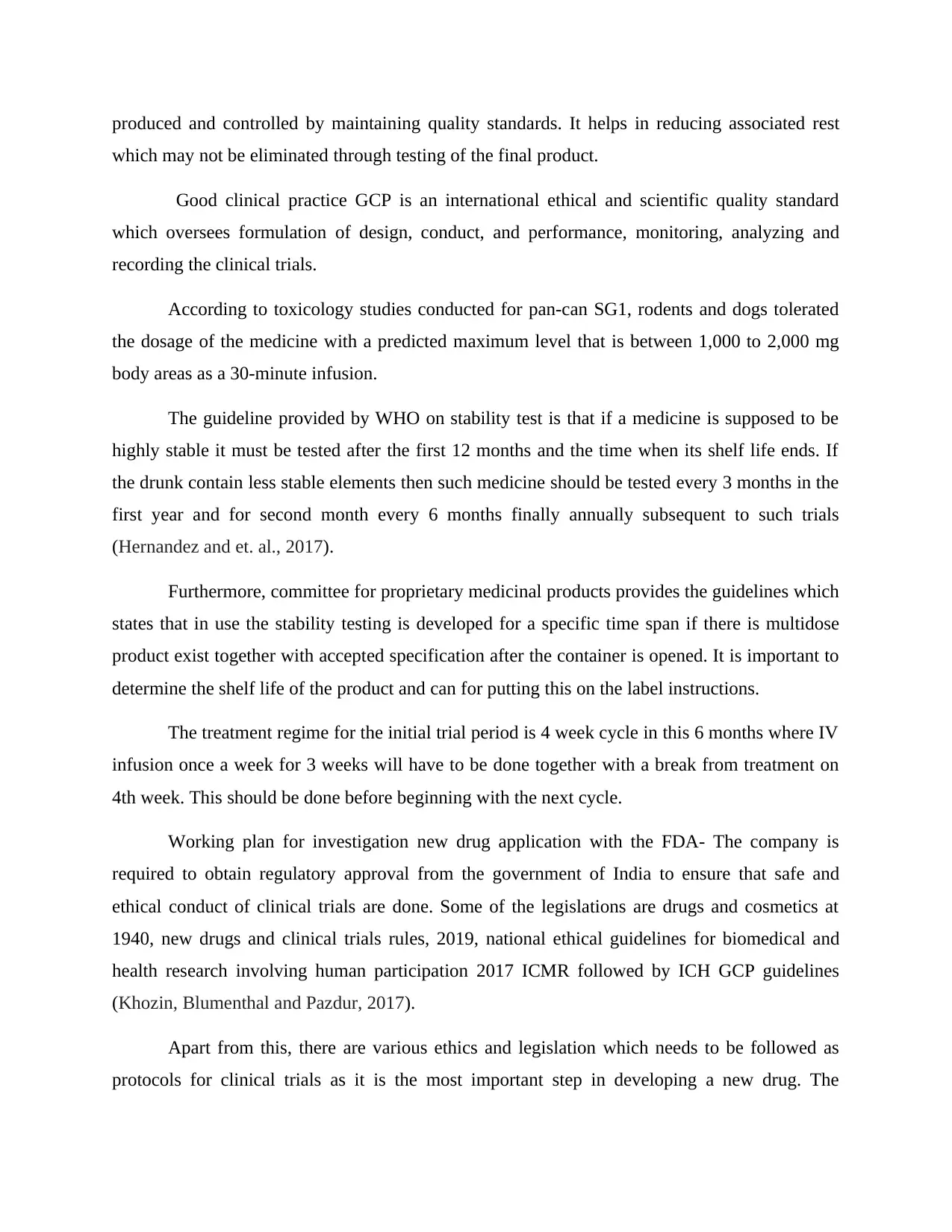
produced and controlled by maintaining quality standards. It helps in reducing associated rest
which may not be eliminated through testing of the final product.
Good clinical practice GCP is an international ethical and scientific quality standard
which oversees formulation of design, conduct, and performance, monitoring, analyzing and
recording the clinical trials.
According to toxicology studies conducted for pan-can SG1, rodents and dogs tolerated
the dosage of the medicine with a predicted maximum level that is between 1,000 to 2,000 mg
body areas as a 30-minute infusion.
The guideline provided by WHO on stability test is that if a medicine is supposed to be
highly stable it must be tested after the first 12 months and the time when its shelf life ends. If
the drunk contain less stable elements then such medicine should be tested every 3 months in the
first year and for second month every 6 months finally annually subsequent to such trials
(Hernandez and et. al., 2017).
Furthermore, committee for proprietary medicinal products provides the guidelines which
states that in use the stability testing is developed for a specific time span if there is multidose
product exist together with accepted specification after the container is opened. It is important to
determine the shelf life of the product and can for putting this on the label instructions.
The treatment regime for the initial trial period is 4 week cycle in this 6 months where IV
infusion once a week for 3 weeks will have to be done together with a break from treatment on
4th week. This should be done before beginning with the next cycle.
Working plan for investigation new drug application with the FDA- The company is
required to obtain regulatory approval from the government of India to ensure that safe and
ethical conduct of clinical trials are done. Some of the legislations are drugs and cosmetics at
1940, new drugs and clinical trials rules, 2019, national ethical guidelines for biomedical and
health research involving human participation 2017 ICMR followed by ICH GCP guidelines
(Khozin, Blumenthal and Pazdur, 2017).
Apart from this, there are various ethics and legislation which needs to be followed as
protocols for clinical trials as it is the most important step in developing a new drug. The
which may not be eliminated through testing of the final product.
Good clinical practice GCP is an international ethical and scientific quality standard
which oversees formulation of design, conduct, and performance, monitoring, analyzing and
recording the clinical trials.
According to toxicology studies conducted for pan-can SG1, rodents and dogs tolerated
the dosage of the medicine with a predicted maximum level that is between 1,000 to 2,000 mg
body areas as a 30-minute infusion.
The guideline provided by WHO on stability test is that if a medicine is supposed to be
highly stable it must be tested after the first 12 months and the time when its shelf life ends. If
the drunk contain less stable elements then such medicine should be tested every 3 months in the
first year and for second month every 6 months finally annually subsequent to such trials
(Hernandez and et. al., 2017).
Furthermore, committee for proprietary medicinal products provides the guidelines which
states that in use the stability testing is developed for a specific time span if there is multidose
product exist together with accepted specification after the container is opened. It is important to
determine the shelf life of the product and can for putting this on the label instructions.
The treatment regime for the initial trial period is 4 week cycle in this 6 months where IV
infusion once a week for 3 weeks will have to be done together with a break from treatment on
4th week. This should be done before beginning with the next cycle.
Working plan for investigation new drug application with the FDA- The company is
required to obtain regulatory approval from the government of India to ensure that safe and
ethical conduct of clinical trials are done. Some of the legislations are drugs and cosmetics at
1940, new drugs and clinical trials rules, 2019, national ethical guidelines for biomedical and
health research involving human participation 2017 ICMR followed by ICH GCP guidelines
(Khozin, Blumenthal and Pazdur, 2017).
Apart from this, there are various ethics and legislation which needs to be followed as
protocols for clinical trials as it is the most important step in developing a new drug. The
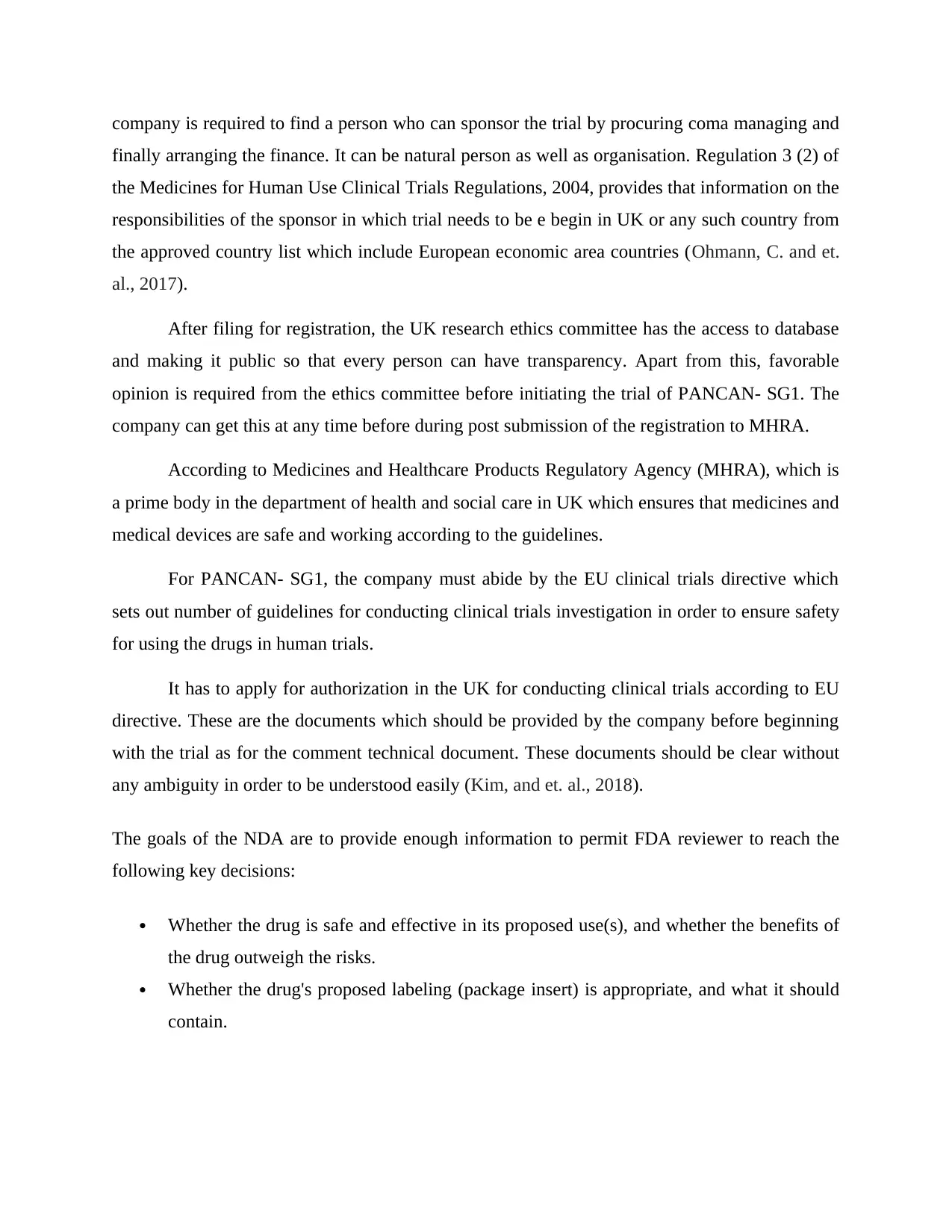
company is required to find a person who can sponsor the trial by procuring coma managing and
finally arranging the finance. It can be natural person as well as organisation. Regulation 3 (2) of
the Medicines for Human Use Clinical Trials Regulations, 2004, provides that information on the
responsibilities of the sponsor in which trial needs to be e begin in UK or any such country from
the approved country list which include European economic area countries (Ohmann, C. and et.
al., 2017).
After filing for registration, the UK research ethics committee has the access to database
and making it public so that every person can have transparency. Apart from this, favorable
opinion is required from the ethics committee before initiating the trial of PANCAN- SG1. The
company can get this at any time before during post submission of the registration to MHRA.
According to Medicines and Healthcare Products Regulatory Agency (MHRA), which is
a prime body in the department of health and social care in UK which ensures that medicines and
medical devices are safe and working according to the guidelines.
For PANCAN- SG1, the company must abide by the EU clinical trials directive which
sets out number of guidelines for conducting clinical trials investigation in order to ensure safety
for using the drugs in human trials.
It has to apply for authorization in the UK for conducting clinical trials according to EU
directive. These are the documents which should be provided by the company before beginning
with the trial as for the comment technical document. These documents should be clear without
any ambiguity in order to be understood easily (Kim, and et. al., 2018).
The goals of the NDA are to provide enough information to permit FDA reviewer to reach the
following key decisions:
Whether the drug is safe and effective in its proposed use(s), and whether the benefits of
the drug outweigh the risks.
Whether the drug's proposed labeling (package insert) is appropriate, and what it should
contain.
finally arranging the finance. It can be natural person as well as organisation. Regulation 3 (2) of
the Medicines for Human Use Clinical Trials Regulations, 2004, provides that information on the
responsibilities of the sponsor in which trial needs to be e begin in UK or any such country from
the approved country list which include European economic area countries (Ohmann, C. and et.
al., 2017).
After filing for registration, the UK research ethics committee has the access to database
and making it public so that every person can have transparency. Apart from this, favorable
opinion is required from the ethics committee before initiating the trial of PANCAN- SG1. The
company can get this at any time before during post submission of the registration to MHRA.
According to Medicines and Healthcare Products Regulatory Agency (MHRA), which is
a prime body in the department of health and social care in UK which ensures that medicines and
medical devices are safe and working according to the guidelines.
For PANCAN- SG1, the company must abide by the EU clinical trials directive which
sets out number of guidelines for conducting clinical trials investigation in order to ensure safety
for using the drugs in human trials.
It has to apply for authorization in the UK for conducting clinical trials according to EU
directive. These are the documents which should be provided by the company before beginning
with the trial as for the comment technical document. These documents should be clear without
any ambiguity in order to be understood easily (Kim, and et. al., 2018).
The goals of the NDA are to provide enough information to permit FDA reviewer to reach the
following key decisions:
Whether the drug is safe and effective in its proposed use(s), and whether the benefits of
the drug outweigh the risks.
Whether the drug's proposed labeling (package insert) is appropriate, and what it should
contain.
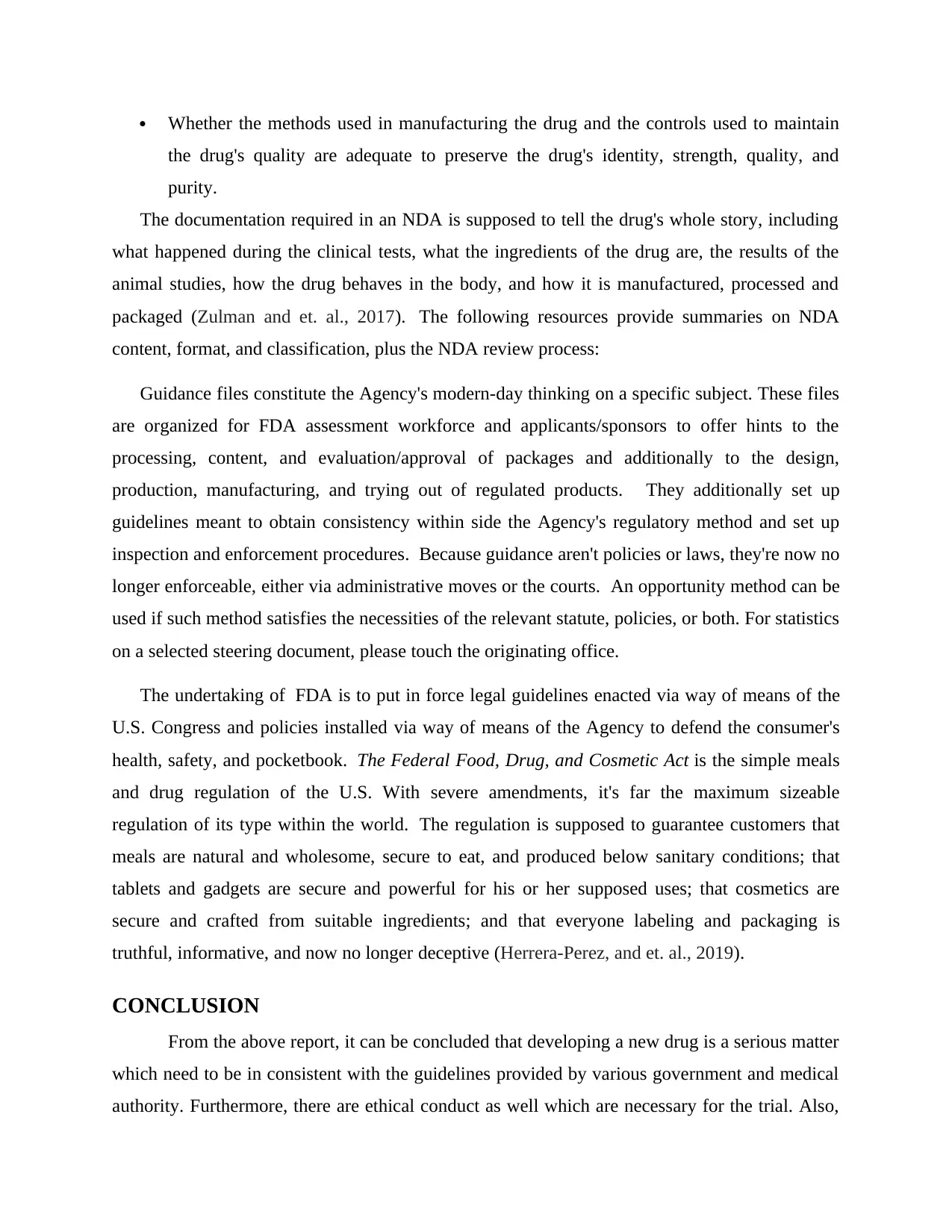
Whether the methods used in manufacturing the drug and the controls used to maintain
the drug's quality are adequate to preserve the drug's identity, strength, quality, and
purity.
The documentation required in an NDA is supposed to tell the drug's whole story, including
what happened during the clinical tests, what the ingredients of the drug are, the results of the
animal studies, how the drug behaves in the body, and how it is manufactured, processed and
packaged (Zulman and et. al., 2017). The following resources provide summaries on NDA
content, format, and classification, plus the NDA review process:
Guidance files constitute the Agency's modern-day thinking on a specific subject. These files
are organized for FDA assessment workforce and applicants/sponsors to offer hints to the
processing, content, and evaluation/approval of packages and additionally to the design,
production, manufacturing, and trying out of regulated products. They additionally set up
guidelines meant to obtain consistency within side the Agency's regulatory method and set up
inspection and enforcement procedures. Because guidance aren't policies or laws, they're now no
longer enforceable, either via administrative moves or the courts. An opportunity method can be
used if such method satisfies the necessities of the relevant statute, policies, or both. For statistics
on a selected steering document, please touch the originating office.
The undertaking of FDA is to put in force legal guidelines enacted via way of means of the
U.S. Congress and policies installed via way of means of the Agency to defend the consumer's
health, safety, and pocketbook. The Federal Food, Drug, and Cosmetic Act is the simple meals
and drug regulation of the U.S. With severe amendments, it's far the maximum sizeable
regulation of its type within the world. The regulation is supposed to guarantee customers that
meals are natural and wholesome, secure to eat, and produced below sanitary conditions; that
tablets and gadgets are secure and powerful for his or her supposed uses; that cosmetics are
secure and crafted from suitable ingredients; and that everyone labeling and packaging is
truthful, informative, and now no longer deceptive (Herrera-Perez, and et. al., 2019).
CONCLUSION
From the above report, it can be concluded that developing a new drug is a serious matter
which need to be in consistent with the guidelines provided by various government and medical
authority. Furthermore, there are ethical conduct as well which are necessary for the trial. Also,
the drug's quality are adequate to preserve the drug's identity, strength, quality, and
purity.
The documentation required in an NDA is supposed to tell the drug's whole story, including
what happened during the clinical tests, what the ingredients of the drug are, the results of the
animal studies, how the drug behaves in the body, and how it is manufactured, processed and
packaged (Zulman and et. al., 2017). The following resources provide summaries on NDA
content, format, and classification, plus the NDA review process:
Guidance files constitute the Agency's modern-day thinking on a specific subject. These files
are organized for FDA assessment workforce and applicants/sponsors to offer hints to the
processing, content, and evaluation/approval of packages and additionally to the design,
production, manufacturing, and trying out of regulated products. They additionally set up
guidelines meant to obtain consistency within side the Agency's regulatory method and set up
inspection and enforcement procedures. Because guidance aren't policies or laws, they're now no
longer enforceable, either via administrative moves or the courts. An opportunity method can be
used if such method satisfies the necessities of the relevant statute, policies, or both. For statistics
on a selected steering document, please touch the originating office.
The undertaking of FDA is to put in force legal guidelines enacted via way of means of the
U.S. Congress and policies installed via way of means of the Agency to defend the consumer's
health, safety, and pocketbook. The Federal Food, Drug, and Cosmetic Act is the simple meals
and drug regulation of the U.S. With severe amendments, it's far the maximum sizeable
regulation of its type within the world. The regulation is supposed to guarantee customers that
meals are natural and wholesome, secure to eat, and produced below sanitary conditions; that
tablets and gadgets are secure and powerful for his or her supposed uses; that cosmetics are
secure and crafted from suitable ingredients; and that everyone labeling and packaging is
truthful, informative, and now no longer deceptive (Herrera-Perez, and et. al., 2019).
CONCLUSION
From the above report, it can be concluded that developing a new drug is a serious matter
which need to be in consistent with the guidelines provided by various government and medical
authority. Furthermore, there are ethical conduct as well which are necessary for the trial. Also,
Paraphrase This Document
Need a fresh take? Get an instant paraphrase of this document with our AI Paraphraser

there should not be any contravention as this may cause huge losses to the company both in
monetary as well as other way.
monetary as well as other way.
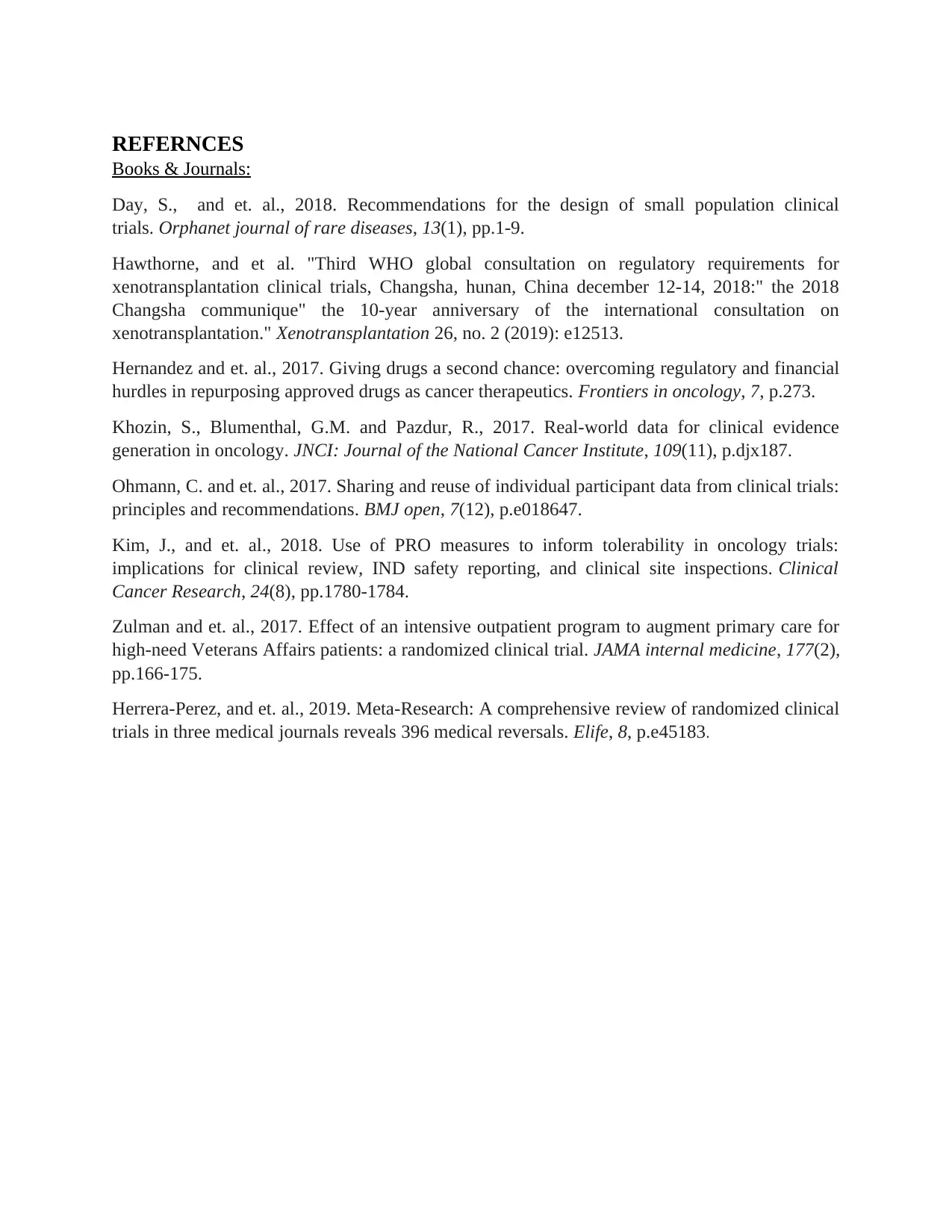
REFERNCES
Books & Journals:
Day, S., and et. al., 2018. Recommendations for the design of small population clinical
trials. Orphanet journal of rare diseases, 13(1), pp.1-9.
Hawthorne, and et al. "Third WHO global consultation on regulatory requirements for
xenotransplantation clinical trials, Changsha, hunan, China december 12-14, 2018:" the 2018
Changsha communique" the 10-year anniversary of the international consultation on
xenotransplantation." Xenotransplantation 26, no. 2 (2019): e12513.
Hernandez and et. al., 2017. Giving drugs a second chance: overcoming regulatory and financial
hurdles in repurposing approved drugs as cancer therapeutics. Frontiers in oncology, 7, p.273.
Khozin, S., Blumenthal, G.M. and Pazdur, R., 2017. Real-world data for clinical evidence
generation in oncology. JNCI: Journal of the National Cancer Institute, 109(11), p.djx187.
Ohmann, C. and et. al., 2017. Sharing and reuse of individual participant data from clinical trials:
principles and recommendations. BMJ open, 7(12), p.e018647.
Kim, J., and et. al., 2018. Use of PRO measures to inform tolerability in oncology trials:
implications for clinical review, IND safety reporting, and clinical site inspections. Clinical
Cancer Research, 24(8), pp.1780-1784.
Zulman and et. al., 2017. Effect of an intensive outpatient program to augment primary care for
high-need Veterans Affairs patients: a randomized clinical trial. JAMA internal medicine, 177(2),
pp.166-175.
Herrera-Perez, and et. al., 2019. Meta-Research: A comprehensive review of randomized clinical
trials in three medical journals reveals 396 medical reversals. Elife, 8, p.e45183.
Books & Journals:
Day, S., and et. al., 2018. Recommendations for the design of small population clinical
trials. Orphanet journal of rare diseases, 13(1), pp.1-9.
Hawthorne, and et al. "Third WHO global consultation on regulatory requirements for
xenotransplantation clinical trials, Changsha, hunan, China december 12-14, 2018:" the 2018
Changsha communique" the 10-year anniversary of the international consultation on
xenotransplantation." Xenotransplantation 26, no. 2 (2019): e12513.
Hernandez and et. al., 2017. Giving drugs a second chance: overcoming regulatory and financial
hurdles in repurposing approved drugs as cancer therapeutics. Frontiers in oncology, 7, p.273.
Khozin, S., Blumenthal, G.M. and Pazdur, R., 2017. Real-world data for clinical evidence
generation in oncology. JNCI: Journal of the National Cancer Institute, 109(11), p.djx187.
Ohmann, C. and et. al., 2017. Sharing and reuse of individual participant data from clinical trials:
principles and recommendations. BMJ open, 7(12), p.e018647.
Kim, J., and et. al., 2018. Use of PRO measures to inform tolerability in oncology trials:
implications for clinical review, IND safety reporting, and clinical site inspections. Clinical
Cancer Research, 24(8), pp.1780-1784.
Zulman and et. al., 2017. Effect of an intensive outpatient program to augment primary care for
high-need Veterans Affairs patients: a randomized clinical trial. JAMA internal medicine, 177(2),
pp.166-175.
Herrera-Perez, and et. al., 2019. Meta-Research: A comprehensive review of randomized clinical
trials in three medical journals reveals 396 medical reversals. Elife, 8, p.e45183.
1 out of 9
Your All-in-One AI-Powered Toolkit for Academic Success.
+13062052269
info@desklib.com
Available 24*7 on WhatsApp / Email
![[object Object]](/_next/static/media/star-bottom.7253800d.svg)
Unlock your academic potential
© 2024 | Zucol Services PVT LTD | All rights reserved.

